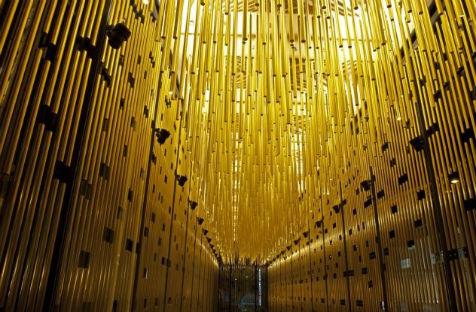I directed the Gala Opening for the much anticipated State Theatre Centre of WA two years ago. It was an honour to be chosen to direct this event and a privilege to work in this wonderful new building. The WA theatre community had waited 30 years for a state theatre. After a lot of broad consultation and $100 million we now had a state of the art venue housing two theatre spaces in the heart of the arts precinct in Northbridge. The venue piqued the public’s interest and thousands of people came for a look in the first days.
The building, which houses the resident companies of Black Swan State Theatre Company (BSSTC) and Perth Theatre Company (PTC) attracted good audiences in its first year. There was also controversy with one external company making a significant loss on a short-term season in the larger salubrious Heath Ledger Theatre (seating 530).
Audience attendance dropped in the second year and the theatre companies are now strategizing to mount seasons, which are attractive to the public whilst also trying to strengthen their individual brand. This is especially hard to do in the Studio Underground (seating 230), which is cost prohibitive and according to theatre companies is an impossible venue to make a profit.
Black Swan wants to produce more small-cast projects in this venue and increase their output in research and development. But it doesn’t have the funding to achieve this and in 2013 it is mounting only one production in the Studio. Perth Theatre Company (PTC), which has claimed the smaller venue as its home, only plans two short run seasons in the Studio Underground this year.
Over the past two years Perth has sadly lost two theatre companies: Sally Burton’s privately run Onward Production and Deckchair Theatre Company. Although they had very different models they were similarly affected by diminishing audiences.
Allanah Lucas, Director General of the Department of Culture and the Arts (DCA), has noted that until the new building the theatre community mounted shows in substandard theatres where the costs did not limit creative output. It has been a shock to many to fully realize the hire expenses involved in mounting a season in the new venue. It is not only the rent of the theatres but the associated costs and personnel, which have limited the amount of production at the venue. STCWA General Manager Brendon Ellmer says that these prices are on a par with equivalent theatres in other states.
Many theatre practitioners and at least one General Manager believe that there is a problem with the “middle man” AEG Ogden – a private company which is the venue managers for Perth Theatre Trust venues, including His Majesty’s Theatre, Perth Concert Hall, the State Theatre Centre of WA and Subiaco Arts Centre. Ogden employs the front-of-house and technical staff for each venue. There is much discontent about the hire costs and the number of staff employed to keep these venues operational.
At the State Theatre Centre, a local seasoned actor is saddened that, in his words, ‘more ushers are being employed than actors in the venue’.
The Perth Theatre Trust (PTT), the government body, which is the principal performing arts operator, argues that the cost of running the theatre will always have to be taken in to account and that employing essential personnel is needed to operate the new venues.
‘Ushers are a valid component of the industry and front-of-house staff are important to the overall experience a patron receives when attending the theatre. Government buildings are governed by legislation and therefore need to be appropriately staffed regardless of how many actors are on the stage,’ says Lucas.
Both Lucas and the General Manager of PTT Alan Ferris feel that theatre companies have been over-ambitious in the first couple of years and have overstretched their resources in relation to the design of productions. This could have affected the number of productions they have mounted. Both say the Studio Underground was originally designed as an experimental, non-traditional, black box venue and perhaps the production aspirations of the companies has exceeded their grasp.
This begs the question how using the theatre for cutting edge works by independent producers and existing theatre companies would be any less impacted by the same crippling overheads.
Venue manager Brendon Ellmer is trying his best to accommodate many vested parties and create a balance of Studio programming between both the resident and commercial companies thus creating diversity. He states that there are six productions occurring at the STCWA for the Perth International Arts Festival in February including two in the underutilised courtyard.
Part of the problem with attracting people to the venue is the vibe. There is no coffee shop or restaurant and more often than not the gates on William St are shut and the courtyard is empty. The bar is buzzy on opening nights but mostly dead during a play’s season. Unlike the rest of Northbridge, the building feels quiet and uninviting. It needs to become a venue that people want to drop in to like the Powerhouse in Brisbane: a place where you can have a drink, a bite to eat, listen to music and see a theatre show.
It is no secret that all of the existing theatre companies desire more funding. DCA feels that there exists a need for more sector discussion dealing with content and collaboration to alleviate the ongoing cries for more money.
Alan Ferris has said that the PTT is conducting a review of programming for the venue early in 2013 and hopes to create some partnerships. Theatre company General Managers Nic Clark (PTC) and Shane Colquhoun (Black Swan) say partnering for the studio may be an option. Partnering for a season in the Studio could effectively reduce costs if there were a number of participants. Alan Ferris states that there needs to be a willingness from all of these parties. Currently none of them have contacted him about this.
Partnering could prove to be problematic with the companies wanting to stake out a particular time frame and express their own distinct brand. I would like to suggest that collaboration and cooperation is not only necessary but essential! There is so much other entertainment in the market place such as big end musicals, bands and comedy acts that we need to think smart and be strategic about how we develop and increase our theatre going audiences in Western Australia.
There also needs to be a strong commitment from governments (federal and state), theatre companies, commercial companies, PTT and AEG Ogden to fully activate this exciting venue and attract audiences.





